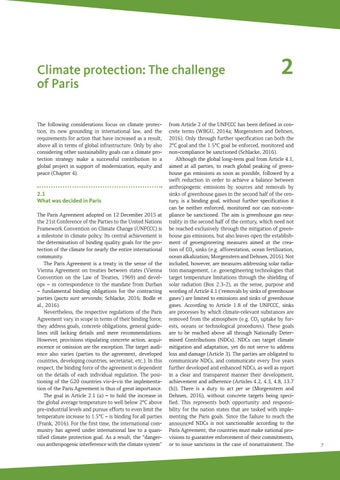Climate protection: The challenge of Paris The following considerations focus on climate protection, its new grounding in international law, and the requirements for action that have increased as a result, above all in terms of global infrastructure. Only by also considering other sustainability goals can a climate protection strategy make a successful contribution to a global project in support of modernization, equity and peace (Chapter 4).
2.1 What was decided in Paris The Paris Agreement adopted on 12 December 2015 at the 21st Conference of the Parties to the United Nations Framework Convention on Climate Change (UNFCCC) is a milestone in climate policy. Its central achievement is the determination of binding quality goals for the protection of the climate for nearly the entire international community. The Paris Agreement is a treaty in the sense of the Vienna Agreement on treaties between states (Vienna Convention on the Law of Treaties, 1969) and develops – in correspondence to the mandate from Durban – fundamental binding obligations for the contracting parties (pacta sunt servanda; Schlacke, 2016; Bodle et al., 2016). Nevertheless, the respective regulations of the Paris Agreement vary in scope in terms of their binding force; they address goals, concrete obligations, general guidelines still lacking details and mere recommendations. However, provisions stipulating concrete action, acquiescence or omission are the exception. The target audience also varies (parties to the agreement, developed countries, developing countries, secretariat, etc.). In this respect, the binding force of the agreement is dependent on the details of each individual regulation. The positioning of the G20 countries vis-à-vis the implementation of the Paris Agreement is thus of great importance. The goal in Article 2.1 (a) – to hold the increase in the global average temperature to well below 2°C above pre-industrial levels and pursue efforts to even limit the temperature increase to 1.5°C – is binding for all parties (Frank, 2016). For the first time, the international community has agreed under international law to a quantified climate protection goal. As a result, the “dangerous anthropogenic interference with the climate system”
2
from Article 2 of the UNFCCC has been defined in concrete terms (WBGU, 2014a; Morgenstern and Dehnen, 2016). Only through further specification can both the 2°C goal and the 1.5°C goal be enforced, monitored and non-compliance be sanctioned (Schlacke, 2016). Although the global long-term goal from Article 4.1, aimed at all parties, to reach global peaking of greenhouse gas emissions as soon as possible, followed by a swift reduction in order to achieve a balance between anthropogenic emissions by sources and removals by sinks of greenhouse gases in the second half of the century, is a binding goal, without further specification it can be neither enforced, monitored nor can non-compliance be sanctioned. The aim is greenhouse gas neutrality in the second half of the century, which need not be reached exclusively through the mitigation of greenhouse gas emissions, but also leaves open the establishment of geoengineering measures aimed at the creation of CO2 sinks (e.g. afforestation, ocean fertilization, ocean alkalization; Morgenstern and Dehnen, 2016). Not included, however, are measures addressing solar radiation management, i.e. geoengineering technologies that target temperature limitations through the shielding of solar radiation (Box 2.3-2), as the sense, purpose and wording of Article 4.1 (‘removals by sinks of greenhouse gases’) are limited to emissions and sinks of greenhouse gases. According to Article 1.8 of the UNFCCC, sinks are processes by which climate-relevant substances are removed from the atmosphere (e.g. CO2 uptake by forests, oceans or technological procedures). These goals are to be reached above all through Nationally Determined Contributions (NDCs). NDCs can target climate mitigation and adaptation, yet do not serve to address loss and damage (Article 3). The parties are obligated to communicate NDCs, and communicate every five years further developed and enhanced NDCs, as well as report in a clear and transparent manner their development, achievement and adherence (Articles 4.2, 4.3, 4.8, 13.7 (b)). There is a duty to act per se (Morgenstern and Dehnen, 2016), without concrete targets being specified. This represents both opportunity and responsibility for the nation states that are tasked with implementing the Paris goals. Since the failure to reach the announced NDCs is not sanctionable according to the Paris Agreement, the countries must make national provisions to guarantee enforcement of their commitments, or to issue sanctions in the case of nonattainment. The
7
